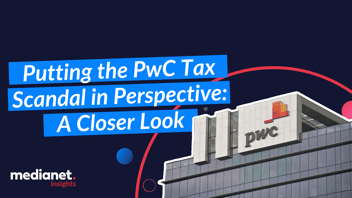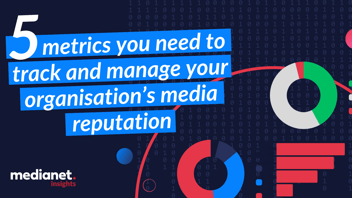Navigating Stormy Waters: The Role of Media Intelligence in Crisis Management
.png?width=1080&height=169&name=Brand%20design%20Blog%20topper%20image%20template%20(3).png)
In the dynamic world of public relations, navigating a crisis is akin to steering a ship through a storm. The right tools can mean the difference between capsizing and reaching safer waters. Media intelligence, such as Medianet’s all-in-one intelligence platform, with its detailed human analysis of media coverage, provides a compass for PR professionals to navigate the swells and calms of today’s media landscape (or should we say, seascape!).
Here’s how media intelligence can play a crucial role in crisis management through each phase: pre-crisis preparation, during crisis management, and post-crisis recovery.
Pre-Crisis Preparation: Setting Sail
Before setting sail, a prudent captain studies the weather and charts a course to avoid storms. The same applies to organisations navigating their future media and communications strategy. A business that receives regular media insights can get a baseline view of its coverage and pinpoint big changes in its media landscape or industry, giving it the ability to quickly discern emerging themes and issues.
Deeper analysis can also pinpoint specific vulnerabilities, much like identifying weak points in a ship's hull. For instance, by tracking metrics that inform entity-based sentiment, perception and awareness, a company can catch an increase in negative coverage related to its environmental practices. Intercepting issues as they emerge can inform a targeted and coordinated strategy that may highlight recent improvements made in the company’s processes, or collaborations between the company, government and environmental organisations. This proactive approach, empowered by media monitoring platform, can prevent a crisis from developing.
.png?width=1920&height=300&name=Brand%20design%20Blog%20topper%20image%20template%20(1).png)
During Crisis Management: Navigating the Storm
When a storm hits, you may need to adjust the original course you set out on. This could mean adjusting the frequency of your reporting to make necessary course corrections. Weekly reporting or more frequent alerts can deliver invaluable insights into how an issue is unfolding and helps you navigate a new course. By tracking the spread and sentiment of news coverage during a public crisis, companies can gauge public reaction and adjust their responses accordingly.
To chart a new way forward, key qualitative metrics are essential.
In addition to sentiment analysis, other metrics such as spokesperson performance, how much coverage has been actively generated (versus incidental or passive coverage), and key themes driving media coverage of your company are crucial when unpacking the impact of a major company crisis.
The sentiment of news will often signpost the best strategic response. If the sentiment is overwhelmingly negative, a company might prioritise empathetic messaging and transparency in their public statements. Whereas if it is mostly positive, then that can be an invitation to dig deeper into what is working. Which themes are driving favourable media and why? Which campaign messages are most frequently communicated? And so on.
The good captain is always vigilant. Even calmer waters invite adjustment of the sails to catch better headwinds.
Post-Crisis Recovery: Anchoring Safely
Once the immediate storm has passed, assessing the damage is crucial.
Post-crisis reporting can be used to evaluate the crisis's impact by analysing both traditional media coverage and social media discussions to drill into the full spectrum of public sentiment. Just as the crew checks a ship for damages after weathering a storm, so too must businesses look plainly at issues-rich media to understand what went wrong.
Longer-term retrospective insights give rise to evidence-based recommendations that can drive success for long-term PR strategies and set up companies to navigate future storms. This might involve addressing any lingering negative perceptions or reinforcing positive aspects that emerged during the crisis.
Continuous reporting after the crisis is a crucial step that cannot be missed. Asking “why” something happened, and “how” we can prevent it from happening again can only be ascertained by looking back in the rearview mirror and being honest about your profile in the media. This gives companies a way to future-proof themselves and learn from their past decisions.
Conclusion: The Power of Media Intelligence
Qualitative research, sentiment analysis, and metrics that drill into media performance and impact are all core tenets of a successful media intelligence strategy.
Navigating a PR crisis without media intelligence is like sailing without a compass. The detailed human analysis provided by a media intelligence platform equips businesses with the insights needed to anticipate, manage, and recover from crises. By leveraging these insights, companies can not only weather the storm but also strengthen their brand and emerge more resilient.
In today’s fast-paced media landscape, investing in robust media intelligence solutions is essential. It ensures that businesses are prepared to handle crises effectively, protecting their reputation and maintaining public trust.
Also, by choosing a service that prioritises transparency and adaptability, organisations can ensure they receive the intelligence they need to succeed without the burden of hidden fees—making it crucial to be vigilant about what exactly is included in your media monitoring contract, and what isn’t. Services like those from Medianet offer flexible, transparent plans and disruptive pricing that empower clients with clear pricing without hidden costs.
In the end, much like a skilled captain uses tools and knowledge to navigate stormy seas, PR professionals can rely on media intelligence to guide them through crises, ensuring they successfully navigate to calmer waters.
🛥️🛥️🛥️
Curious to know more about Medianet's all-in-one media intelligence solution, read this article.
For more insights, subscribe to our newsletter or contact us for a demo.
Media Monitoring v/s Media Analysis? What to expect? Click this link to learn more.


.png?width=1920&height=300&name=Brand%20design%20Blog%20topper%20image%20template%20(2).png)
.png?width=1920&height=300&name=Brand%20design%20Blog%20topper%20image%20template%20(4).png)


